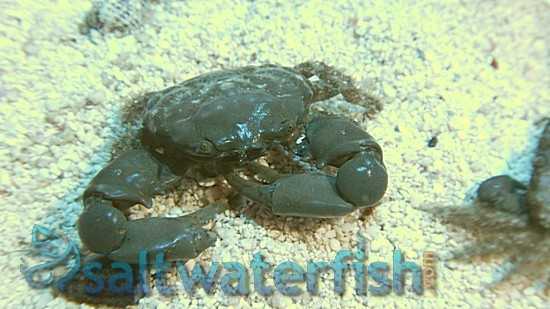Emerald Crab (Mythrax sculptus)
Quick Stats:
- Care Level: Easy
- Temperament: Peaceful
- Diet: Omnivore
- Reef Safe: Yes
- Minimum Tank Size: 10 gallons
- Maximum Size: 2 inches
- Water Parameters: pH 8.1-8.4, salinity 1.023-1.025, temperature 72-78°F
Comprehensive Guide to the Emerald Crab (Mythrax sculptus)
Habitat
The Emerald Crab, also known as Mythrax sculptus, is commonly found in the Western Atlantic Ocean, ranging from the coast of North Carolina to the Caribbean Sea. They inhabit rocky areas, coral reefs, and seagrass beds.
Reef Safe
The Emerald Crab is generally considered reef safe. It is unlikely to harm corals, but caution should be exercised if keeping it with small or delicate polyps, as they may be nipped at. It is generally safe to keep with most other reef inhabitants.
Reef Cleaner
The Emerald Crab is often considered a reef cleaner due to its feeding habits. It will actively search for and consume detritus, uneaten food, and algae in the aquarium. This can help maintain a clean and healthy reef environment.
Size
The Emerald Crab typically grows to a maximum size of around 2 inches. However, size can vary depending on the individual and the conditions in which it is kept.
Sexual Dimorphism
There is no significant sexual dimorphism in the Emerald Crab, making it difficult to visually determine the sex of an individual.
Lifespan
The average lifespan of an Emerald Crab is around 2-3 years, although with proper care, some individuals may live longer.
Diet in Aquariums
The Emerald Crab is an omnivore and will eat a variety of foods. In the aquarium, it should be provided with a balanced diet that includes both meaty and plant-based foods. This can include commercial crab or shrimp pellets, algae wafers, and small meaty foods like brine shrimp or mysis shrimp.
Aquacultured Availability
The Emerald Crab is currently aquacultured and readily available to hobbyists. This means that specimens are bred and raised in captivity, reducing the impact on wild populations and ensuring a sustainable source for the aquarium trade.
Compatibility with Other Tankmates
The Emerald Crab is generally compatible with a wide range of fish, invertebrates, and corals. However, caution should be exercised when keeping it with very small or delicate species. It is generally best to avoid keeping it with aggressive or territorial fish that may harass or attack the crab.
Five tankmates that are good choices to keep with the Emerald Crab include:
- Clownfish: They are peaceful and can coexist with the crab without any issues.
- Firefish: These small, peaceful fish make great tankmates for the Emerald Crab.
- Cleaner Shrimp: They can help maintain a clean and healthy aquarium environment alongside the crab.
- Soft Corals: Many soft corals are compatible with the Emerald Crab and can add color and beauty to the tank.
- Snails: Snails are excellent tankmates as they also help with algae control and provide additional interest to the aquarium.
Temperament
The Emerald Crab is generally peaceful and non-aggressive. It is unlikely to bother other tank inhabitants unless it feels threatened or is competing for food. It is a relatively low-maintenance and easy-to-care-for species.
Other Common Names
The Emerald Crab is also known by other common names such as Green Emerald Crab and Mithrax Crab.
Why Buy from Reefs4Less.com
Reefs4Less.com is a reputable online retailer specializing in saltwater aquarium supplies. They offer a wide range of high-quality products, including livestock like the Emerald Crab. With a strong focus on customer satisfaction and competitive pricing, Reefs4Less.com is a trusted source for all your aquarium needs.
Popular Questions and Answers
- Q: Can the Emerald Crab be kept in a nano reef tank?
A: Yes, the Emerald Crab can be kept in a nano reef tank as long as the tank meets the minimum size requirement of 10 gallons. However, it is important to ensure that the tank is properly maintained and provides enough hiding places for the crab. - Q: Will the Emerald Crab eat corals?
A: The Emerald Crab is generally considered reef safe and is unlikely to harm corals. However, caution should be exercised if keeping it with small or delicate polyps, as they may be nipped at. - Q: How often should the Emerald Crab be fed?
A: The Emerald Crab should be fed small amounts of food 2-3 times a week. It is important to avoid overfeeding, as this can lead to poor water quality. - Q: Can the Emerald Crab be kept with aggressive fish?
A: It is generally best to avoid keeping the Emerald Crab with aggressive or territorial fish that may harass or attack the crab. It is best to choose tankmates that are peaceful and compatible with the crab. - Q: How can I ensure the long-term health of the Emerald Crab?
A: To ensure the long-term health of the Emerald Crab, provide a well-maintained aquarium with proper water parameters, a balanced diet, and suitable tankmates. Regular observation and monitoring of the crab’s behavior and appearance can help detect any potential health issues early on.


Reviews
There are no reviews yet.